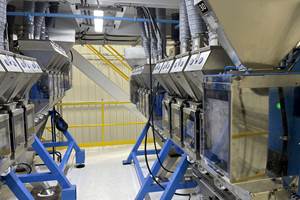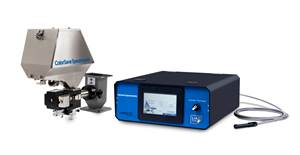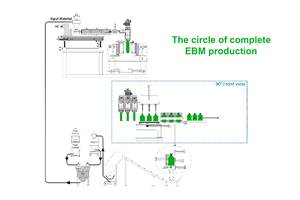The 3-to-7-Minute Color Change—Step 2: Preparation & Equipment
Hopper and screw and barrel considerations come into play as do strategies: press-side loading, satellite hoppers or a combination of both?
In NASCAR, a pit stop is a planned event that utilizes a well-trained crew, which has all the tools needed to perform its job quickly and methodically. The same principles apply to color changeovers. Your team needs to be properly trained in the fastest approach procedure to perform the changeover quickly. Your workers also need to have all the tools available to them that help them to perform their duties easily.
Hopper- Shutting down the press to clean a hopper is ineffective and adds to overall down time. The best way to avoid this is to keep the press running as the hopper is cleaned. There are a couple of ways to remove the hopper from the downtime equation.
The more expensive approach would be the use of a satellite hopper. This hopper would be mobile, allowing for the next color to be staged prior to changeover. When the job completes, the loader for the feed throat is removed from the stationary hopper and attached to the satellite hopper. The press is restarted, using material from the satellite hopper while the stationary hopper is cleaned and reloaded.
When the stationary hopper is ready, the mobile unit is removed from the area, cleaned and prepped for the next changeover. This method works extremely well for materials that don’t require dry time. However, when material requires drying, the throughput of the satellite dryer needs to allow for drying the new material. If the satellite hopper only holds 2 hours worth of material, but you need 4 hours to dry the material in the hopper, you still have 2 hours of unnecessary downtime. Plan your equipment and approach.
The goal of any facility that practices lean manufacturing ideologies is for color changes to typically take between 3 to 7 minutes; 15 minutes if there are complications such as hot runner use or above normal purging needs.
Press-Side Loading is method is far more economical, and easier to implement. The hose is disconnected from the hopper, and draws material from a bucket or small container while the hopper is being cleaned. When utilizing this approach, remember that material taken out of a dryer can be used for up to an hour without drawing in enough moisture to affect your process. Based on this information, material can be drained from the hopper 1 hour before the order is complete so the hopper can be cleaned and prepped for the next color. Again, it is important to note that material that requires drying time can affect your ability to quickly change colors. One way around this is to use material that is vacuum packed in a foil bag. In most cases the material was packed hot, which removes the moisture in the pellet and because of the packaging technique moisture isn’t able to get back in. Calculate how many pounds you will need for proper drying time and fill the hopper using the foil bags first.
Combination: In this method, material is dried at another location in preparation for the changeover. The hose is removed from the hopper 1 hour prior to the changeover to allow for cleaning of the dryer to take place. The press continues to run out of a bucket or barrel until the order is complete. Dry material is loaded into the hopper prior to the changeover. It is important to note that the amount of dry material loaded depends upon the amount of dry time required for the wet material that was loaded on top of the dry material. It is also recommended that you load enough material to supply your machine with 1 hour of extra drying. This helps to compensate for non-dried material that funnels through the center of the hopper.
Screw & Barrel: Part of quick changeover depends on having presses outfitted with one shot loaders. Hose lengths should be limited to only what is needed to attach to hopper and one shot, allowing enough slack to move barrel back and forth. The hopper side of hose should be outfitted for easy conversion to a material wand, and vice versa. In preparation for establishing a changeover procedure, shut the material loader off with the press running the job that you are creating a procedure for. Make sure the loader is shut off with the crew having rotated back, waiting for the mold to open. After the shot in the mold is ejected, begin counting how many cycles the press runs before the screw runs dry. This gives you the shot throughput. Record this number for later use which will be outlined in this article.
Next Week—Step 3: Color Planning
ABOUT THE AUTHOR: Garrett MacKenzie is the owner and editor of www.plastic411.com. MacKenzie has held engineering/management positions for 16 years, and his plastics career spans more than three decades. He currently provides training in plastics injection molding. His next training event is a Scientific Molding Work Shop, to be held in Dalton, GA from March 24-25, 2018. For more information about the event, visit the plastic411.com website. He can also be reached at: training@plastic411.com.
Related Content
Novel System Produces Color on Demand
Ampacet’s FluxQF technology features a quick-dispersion universal carrier with novel machinery that provides automated color blending in quantities down to 50 lb.
Read MoreColor-Measurement for Extrusion, Molding
System helps processors control the cost of quality due to color variations, using real-time color data for QC analytics and color optimization.
Read MoreDSM Launches an AI Powered Color & Mechanical Properties Prediction Tool
Called Lucidiris, this prediction tool can reduce time to market when developing colors of high-performance materials for a variety of applications.
Read MoreGet Color Changes Right In Extrusion Blow Molding
Follow these best practices to minimize loss of time, material and labor during color changes in molding containers from bottles to jerrycans. The authors explore what this means for each step of the process, from raw-material infeed to handling and reprocessing tails and trim.
Read MoreRead Next
Troubleshooting Screw and Barrel Wear in Extrusion
Extruder screws and barrels will wear over time. If you are seeing a reduction in specific rate and higher discharge temperatures, wear is the likely culprit.
Read MoreLead the Conversation, Change the Conversation
Coverage of single-use plastics can be both misleading and demoralizing. Here are 10 tips for changing the perception of the plastics industry at your company and in your community.
Read MoreHow Polymer Melts in Single-Screw Extruders
Understanding how polymer melts in a single-screw extruder could help you optimize your screw design to eliminate defect-causing solid polymer fragments.
Read More


























